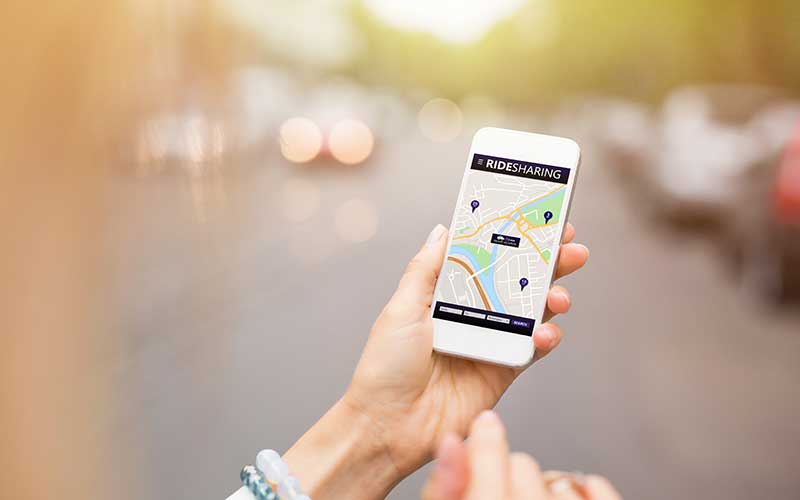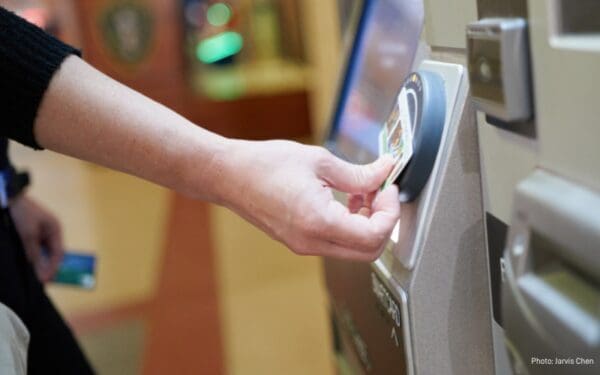
Ride-hailing services like Uber and Lyft say they're good for the environment – but a new report shows they actually make congestion, pollution, and climate-damaging emissions worse. Photo: ©Kaspars Grinvald via Shutterstock
If you recently deleted your Uber app in response to the consumer boycott over the ride-hailing company’s behavior during the protests against Trump’s travel ban, you may want to think twice before you reinstall it. While Uber has amassed at least three more scandals since then, a new report is also giving us a first glimpse into the negative impacts all ride-hailing services may have on the environment.
Lyft and Uber have long boasted that their services take cars off the roads and reduce the carbon footprint of our transportation system. But the data doesn’t bear out these assertions. The report, released earlier this week, presents findings from a detailed analysis of the growth of app-based ride services in New York City; their impacts on traffic, travel patterns, and vehicle mileage since 2013; and their implications for climate change.
The report concludes that putting more Uber and Lyft drivers on New York’s roads is not a sustainable way to grow the city. They will make the city’s famously congested streets even more jammed, which will lead to mounting costs for businesses and consumers from increasing traffic delays. Their growth also threatens to hinder progress toward New York’s goals for mobility, economic growth, and the environment.
What Does the Data Show?
- Initially, ride-hailing companies (called Transportation Network Companies, or TNCs, in the report) grew mostly by attracting taxi passengers.
- Since June 2015, however, TNC passenger volumes have tripled to 500,000 riders per day, a rate of growth that far outpaced the drop in yellow cab rides. This means that riders are now choosing ride-hailing services over public transportation, walking, and biking, all of which emit little or no climate-damaging greenhouse gases and air pollution.
- As a result of growing trip volumes, TNCs added 600 million miles of driving to city streets in 2016 – more than the total mileage driven by yellow cabs in Manhattan during the same period. With those added miles came about 550 million pounds of greenhouse gas emissions (the equivalent of emissions from the energy used by more than 26,000 homes in one year).
- Nearly half – 49% – of those additional 600 million miles were without a passenger, i.e., from driving to the pickup point or to a busier area. This makes TNC rides less efficient than driving and parking a private vehicle, since almost double the miles have to be driven to move people the same distance.
- TNCs made the most congested areas in the city even more so, adding an estimated 7 percent to existing miles driven by all vehicles in those areas from 2013 to 2016.
- Ride-hailing services are undercutting public transportation. Prior to the arrival of TNCs, mass transit absorbed the growth in travel from new residents and workers throughout the city. That meant the city could grow sustainably. Since 2013, however, this has changed. As TNC ridership growth has accelerated, subway and bus ridership has declined.
- Since mid-2015 TNCs have offered and heavily promoted “pooled” options such as UberPool and LyftLine. TNC mileage nonetheless continued to grow rapidly because exclusive-ride trips still predominate, and because most TNC customers are coming from transit, walking, and biking. Migration from these modes translates to increased mileage even if TNC rides are shared.
What Does This Mean for New England?
In most parts of the country, including New England, it is hard to assess the impact of TNCs on the environment because these privately held companies closely guard data on their operations. In New York City, TNCs are required to submit trip records, and mileage data is available from mandated vehicle inspections, making sufficient information available for the study.
Regardless, it is reasonable to assume that similar conclusions are likely for other areas of the country. Boston, for example, anecdotally has one of the highest ride-hailing rates in the nation. As a result, Uber and Lyft are probably also gradually replacing walking, biking, and public transportation and swelling the total vehicle miles driven here in New England. This means increased greenhouse gas emissions here, along with more local and regional air pollution.
The Long-term Cost of Short-term Convenience
While more research (and access to data) is needed, it’s safe to infer that TNCs as currently used are not helping our climate or improving our air quality. We understand that it can often seem more convenient to choose Lyft or Uber, especially at times when trains and buses are running less frequently. But Styrofoam cups and plastic grocery bags were once considered convenient time savers, too – and today travel mugs and cloth totes are becoming more and more common. The next time you are choosing between hailing a ride or taking the bus, try to consider the long-term costs of that short-term convenience – and which one is more likely to get you to where we all want our planet and our society to go.


